Project on Literacy Learning Centre for Young Children (2-5 years)
VerifiedAdded on 2023/01/09
|12
|3796
|35
Project
AI Summary
This project report focuses on a literacy learning centre designed for children aged 2-5 years. It begins by establishing the rationale and justification for such a centre, emphasizing the importance of literacy in early childhood development. The report then delves into the narrative of children's learning, using a case study of a child named Dora to illustrate how educators can foster literacy skills through innovative methods such as painting and colour experiments. An analysis of the learning process is provided, highlighting the use of smart boards, body language, and facial expressions to overcome language barriers and promote effective English language acquisition. The project also explores intentional teaching strategies, such as scaffolding, and the use of children's literature and multimedia resources to enhance the learning experience. Finally, the report concludes with an educator's reflection on the project, summarizing the key findings and implications for early childhood education and its role in fostering cognitive development.
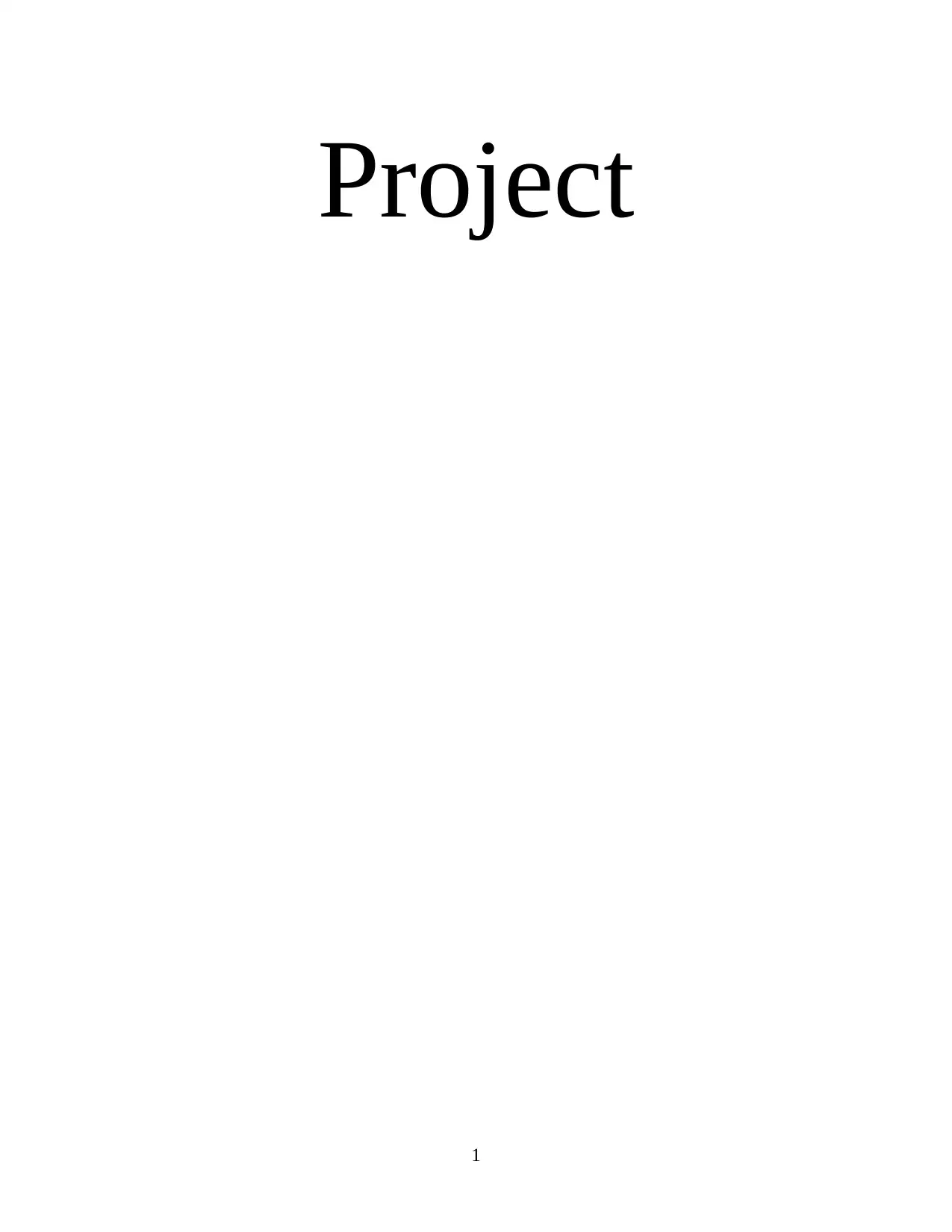
Project
1
1
Paraphrase This Document
Need a fresh take? Get an instant paraphrase of this document with our AI Paraphraser
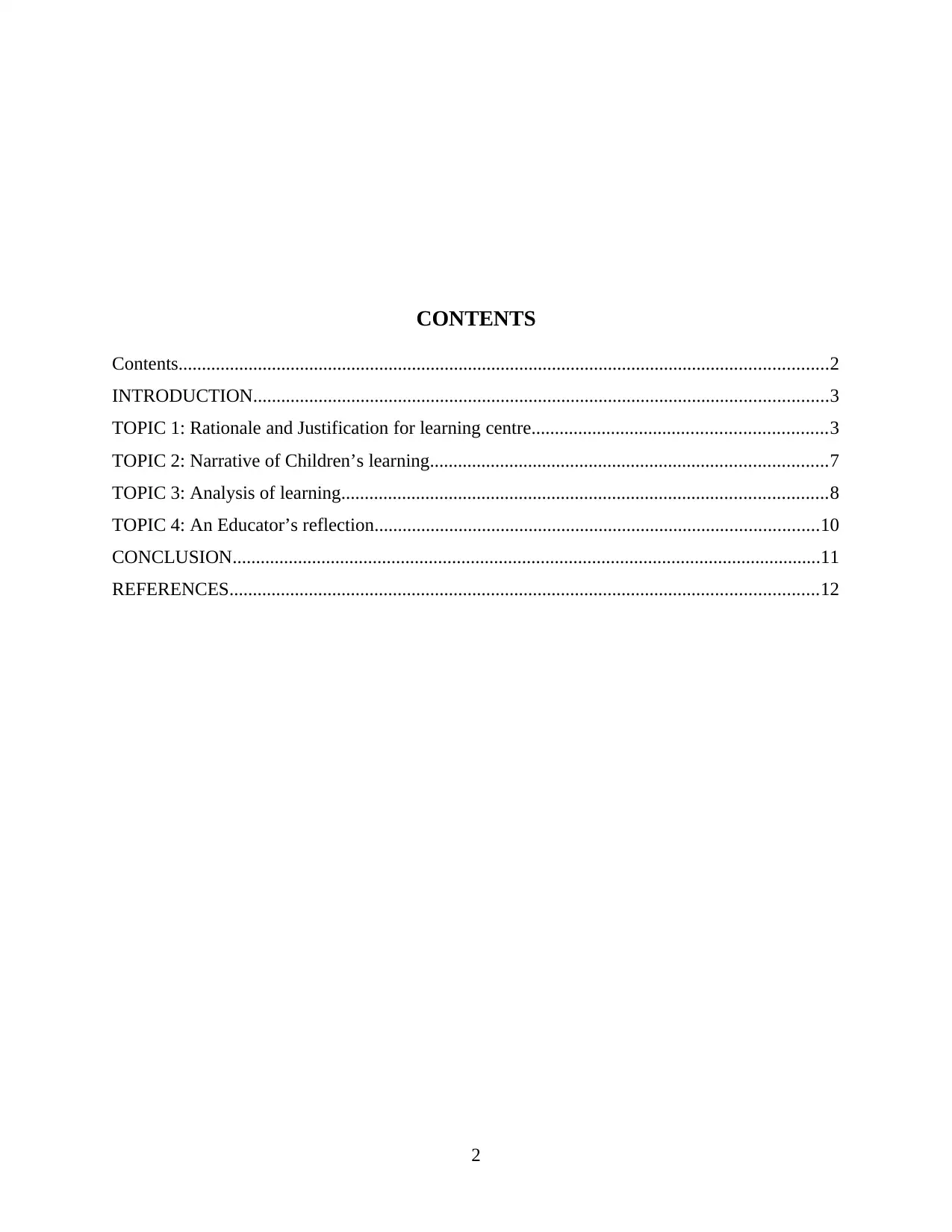
CONTENTS
Contents...........................................................................................................................................2
INTRODUCTION...........................................................................................................................3
TOPIC 1: Rationale and Justification for learning centre...............................................................3
TOPIC 2: Narrative of Children’s learning.....................................................................................7
TOPIC 3: Analysis of learning........................................................................................................8
TOPIC 4: An Educator’s reflection...............................................................................................10
CONCLUSION..............................................................................................................................11
REFERENCES..............................................................................................................................12
2
Contents...........................................................................................................................................2
INTRODUCTION...........................................................................................................................3
TOPIC 1: Rationale and Justification for learning centre...............................................................3
TOPIC 2: Narrative of Children’s learning.....................................................................................7
TOPIC 3: Analysis of learning........................................................................................................8
TOPIC 4: An Educator’s reflection...............................................................................................10
CONCLUSION..............................................................................................................................11
REFERENCES..............................................................................................................................12
2
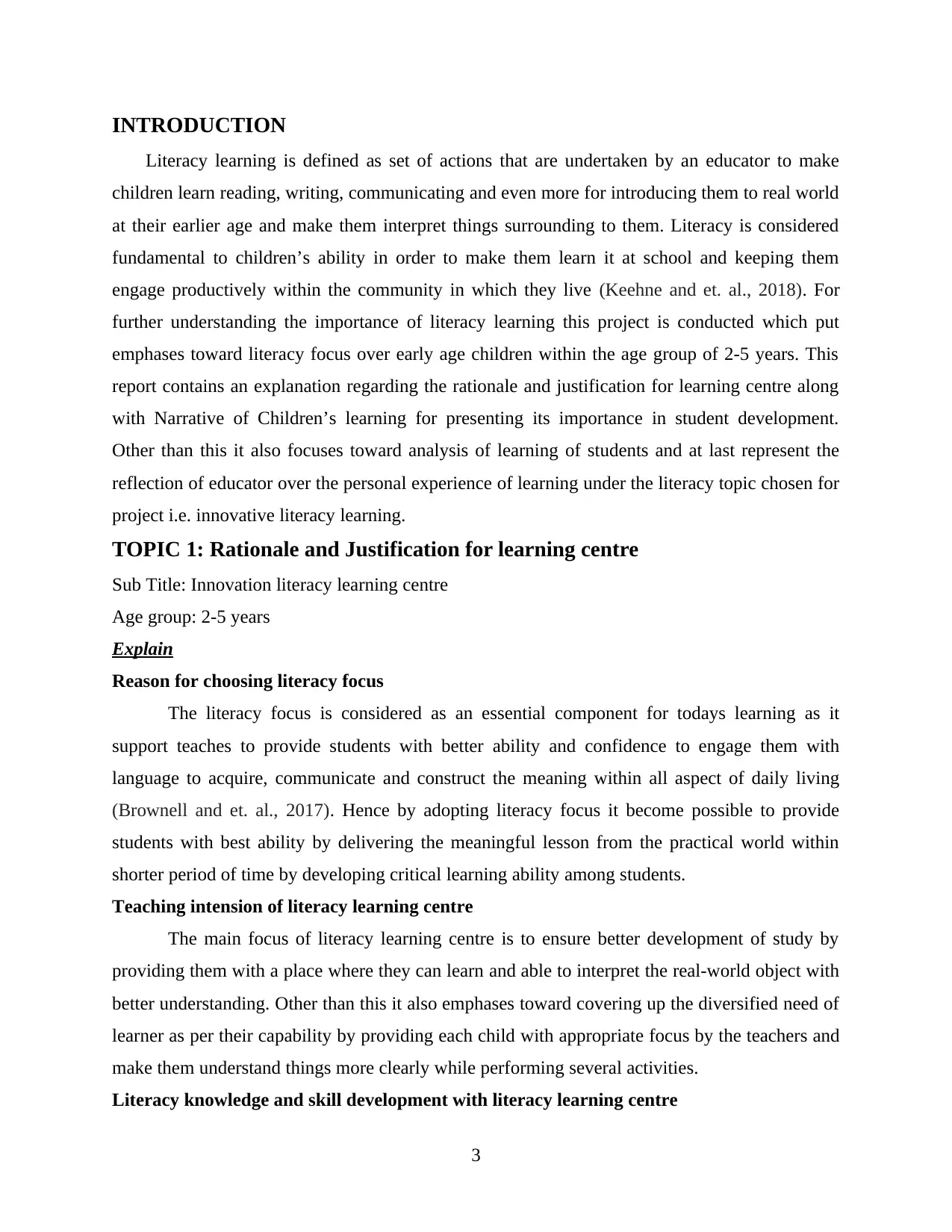
INTRODUCTION
Literacy learning is defined as set of actions that are undertaken by an educator to make
children learn reading, writing, communicating and even more for introducing them to real world
at their earlier age and make them interpret things surrounding to them. Literacy is considered
fundamental to children’s ability in order to make them learn it at school and keeping them
engage productively within the community in which they live (Keehne and et. al., 2018). For
further understanding the importance of literacy learning this project is conducted which put
emphases toward literacy focus over early age children within the age group of 2-5 years. This
report contains an explanation regarding the rationale and justification for learning centre along
with Narrative of Children’s learning for presenting its importance in student development.
Other than this it also focuses toward analysis of learning of students and at last represent the
reflection of educator over the personal experience of learning under the literacy topic chosen for
project i.e. innovative literacy learning.
TOPIC 1: Rationale and Justification for learning centre
Sub Title: Innovation literacy learning centre
Age group: 2-5 years
Explain
Reason for choosing literacy focus
The literacy focus is considered as an essential component for todays learning as it
support teaches to provide students with better ability and confidence to engage them with
language to acquire, communicate and construct the meaning within all aspect of daily living
(Brownell and et. al., 2017). Hence by adopting literacy focus it become possible to provide
students with best ability by delivering the meaningful lesson from the practical world within
shorter period of time by developing critical learning ability among students.
Teaching intension of literacy learning centre
The main focus of literacy learning centre is to ensure better development of study by
providing them with a place where they can learn and able to interpret the real-world object with
better understanding. Other than this it also emphases toward covering up the diversified need of
learner as per their capability by providing each child with appropriate focus by the teachers and
make them understand things more clearly while performing several activities.
Literacy knowledge and skill development with literacy learning centre
3
Literacy learning is defined as set of actions that are undertaken by an educator to make
children learn reading, writing, communicating and even more for introducing them to real world
at their earlier age and make them interpret things surrounding to them. Literacy is considered
fundamental to children’s ability in order to make them learn it at school and keeping them
engage productively within the community in which they live (Keehne and et. al., 2018). For
further understanding the importance of literacy learning this project is conducted which put
emphases toward literacy focus over early age children within the age group of 2-5 years. This
report contains an explanation regarding the rationale and justification for learning centre along
with Narrative of Children’s learning for presenting its importance in student development.
Other than this it also focuses toward analysis of learning of students and at last represent the
reflection of educator over the personal experience of learning under the literacy topic chosen for
project i.e. innovative literacy learning.
TOPIC 1: Rationale and Justification for learning centre
Sub Title: Innovation literacy learning centre
Age group: 2-5 years
Explain
Reason for choosing literacy focus
The literacy focus is considered as an essential component for todays learning as it
support teaches to provide students with better ability and confidence to engage them with
language to acquire, communicate and construct the meaning within all aspect of daily living
(Brownell and et. al., 2017). Hence by adopting literacy focus it become possible to provide
students with best ability by delivering the meaningful lesson from the practical world within
shorter period of time by developing critical learning ability among students.
Teaching intension of literacy learning centre
The main focus of literacy learning centre is to ensure better development of study by
providing them with a place where they can learn and able to interpret the real-world object with
better understanding. Other than this it also emphases toward covering up the diversified need of
learner as per their capability by providing each child with appropriate focus by the teachers and
make them understand things more clearly while performing several activities.
Literacy knowledge and skill development with literacy learning centre
3
⊘ This is a preview!⊘
Do you want full access?
Subscribe today to unlock all pages.

Trusted by 1+ million students worldwide
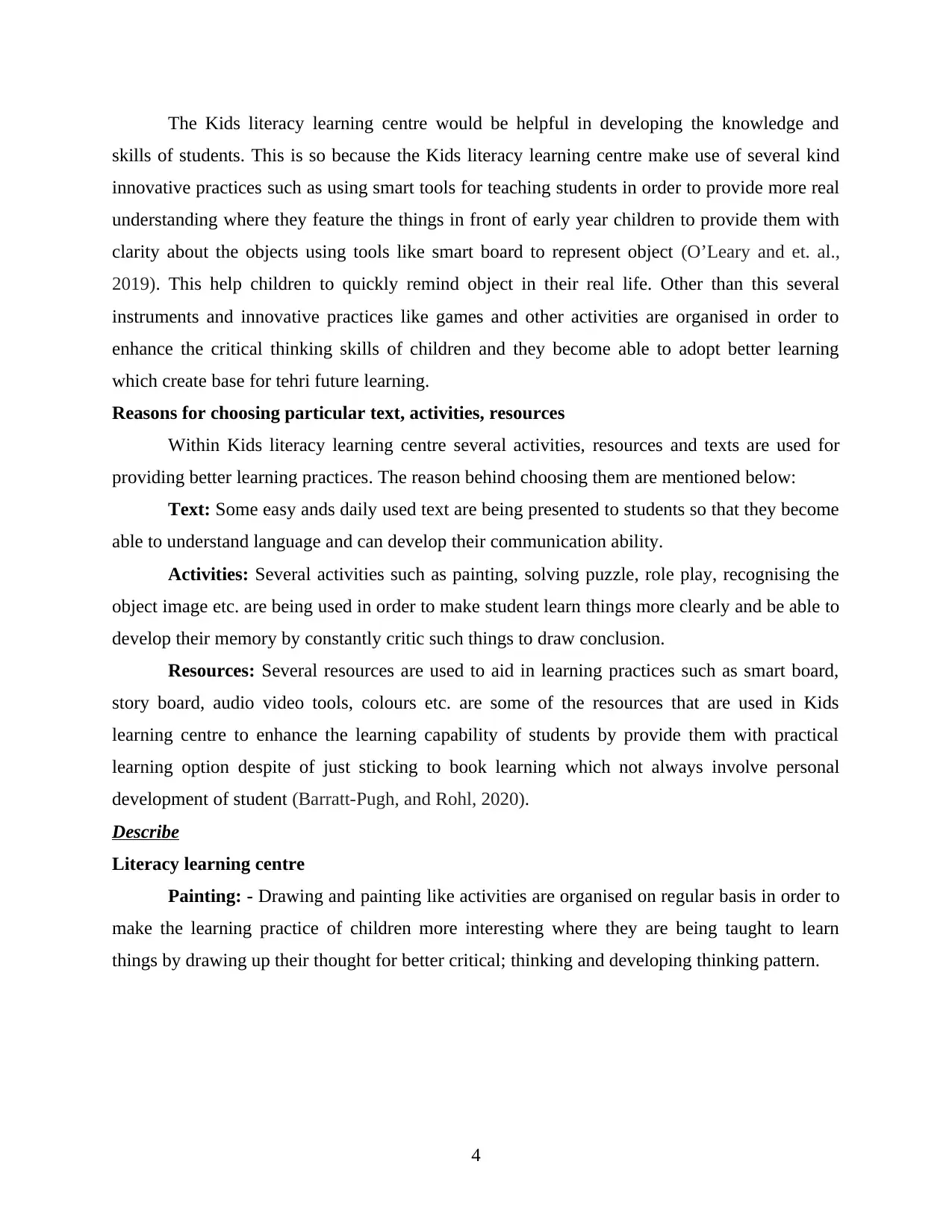
The Kids literacy learning centre would be helpful in developing the knowledge and
skills of students. This is so because the Kids literacy learning centre make use of several kind
innovative practices such as using smart tools for teaching students in order to provide more real
understanding where they feature the things in front of early year children to provide them with
clarity about the objects using tools like smart board to represent object (O’Leary and et. al.,
2019). This help children to quickly remind object in their real life. Other than this several
instruments and innovative practices like games and other activities are organised in order to
enhance the critical thinking skills of children and they become able to adopt better learning
which create base for tehri future learning.
Reasons for choosing particular text, activities, resources
Within Kids literacy learning centre several activities, resources and texts are used for
providing better learning practices. The reason behind choosing them are mentioned below:
Text: Some easy ands daily used text are being presented to students so that they become
able to understand language and can develop their communication ability.
Activities: Several activities such as painting, solving puzzle, role play, recognising the
object image etc. are being used in order to make student learn things more clearly and be able to
develop their memory by constantly critic such things to draw conclusion.
Resources: Several resources are used to aid in learning practices such as smart board,
story board, audio video tools, colours etc. are some of the resources that are used in Kids
learning centre to enhance the learning capability of students by provide them with practical
learning option despite of just sticking to book learning which not always involve personal
development of student (Barratt-Pugh, and Rohl, 2020).
Describe
Literacy learning centre
Painting: - Drawing and painting like activities are organised on regular basis in order to
make the learning practice of children more interesting where they are being taught to learn
things by drawing up their thought for better critical; thinking and developing thinking pattern.
4
skills of students. This is so because the Kids literacy learning centre make use of several kind
innovative practices such as using smart tools for teaching students in order to provide more real
understanding where they feature the things in front of early year children to provide them with
clarity about the objects using tools like smart board to represent object (O’Leary and et. al.,
2019). This help children to quickly remind object in their real life. Other than this several
instruments and innovative practices like games and other activities are organised in order to
enhance the critical thinking skills of children and they become able to adopt better learning
which create base for tehri future learning.
Reasons for choosing particular text, activities, resources
Within Kids literacy learning centre several activities, resources and texts are used for
providing better learning practices. The reason behind choosing them are mentioned below:
Text: Some easy ands daily used text are being presented to students so that they become
able to understand language and can develop their communication ability.
Activities: Several activities such as painting, solving puzzle, role play, recognising the
object image etc. are being used in order to make student learn things more clearly and be able to
develop their memory by constantly critic such things to draw conclusion.
Resources: Several resources are used to aid in learning practices such as smart board,
story board, audio video tools, colours etc. are some of the resources that are used in Kids
learning centre to enhance the learning capability of students by provide them with practical
learning option despite of just sticking to book learning which not always involve personal
development of student (Barratt-Pugh, and Rohl, 2020).
Describe
Literacy learning centre
Painting: - Drawing and painting like activities are organised on regular basis in order to
make the learning practice of children more interesting where they are being taught to learn
things by drawing up their thought for better critical; thinking and developing thinking pattern.
4
Paraphrase This Document
Need a fresh take? Get an instant paraphrase of this document with our AI Paraphraser
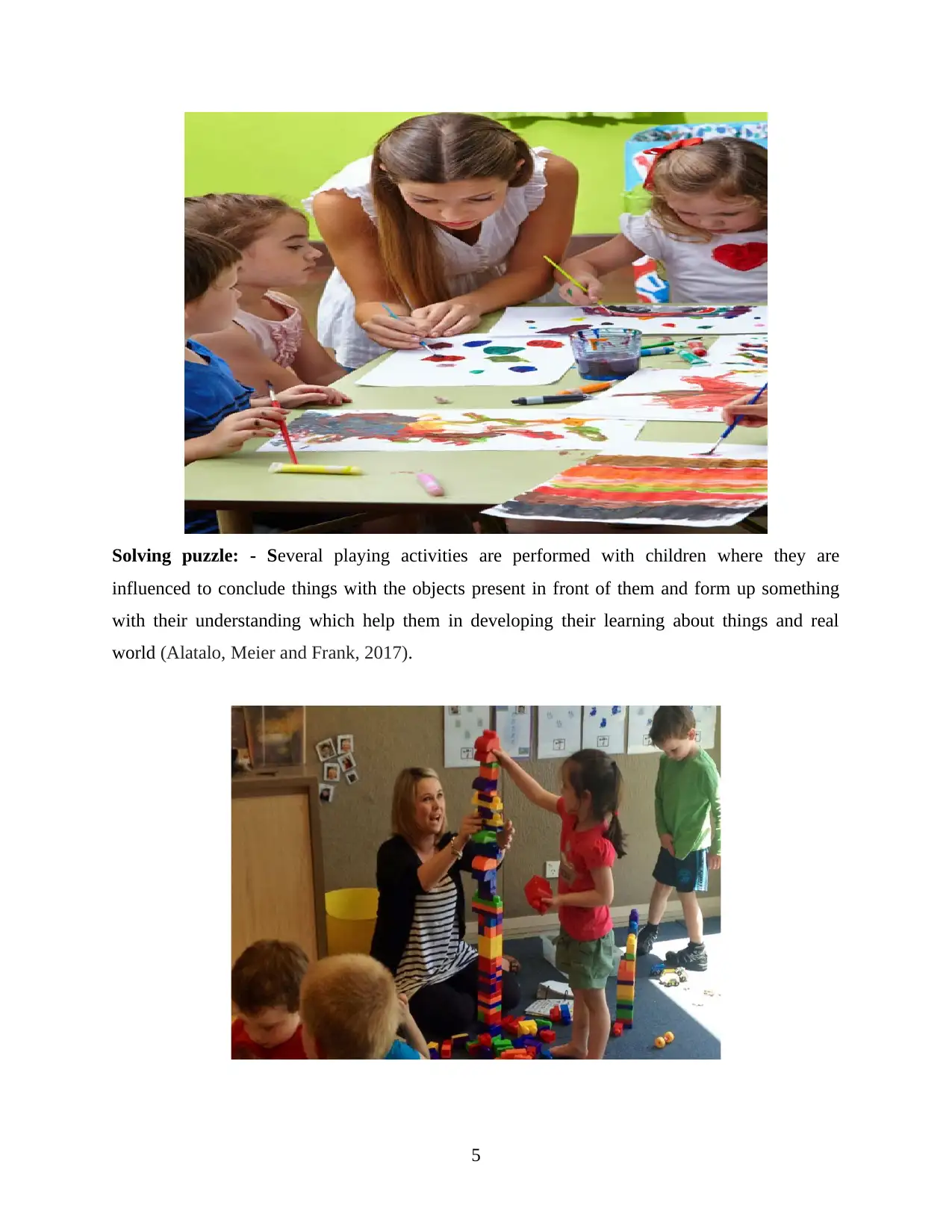
Solving puzzle: - Several playing activities are performed with children where they are
influenced to conclude things with the objects present in front of them and form up something
with their understanding which help them in developing their learning about things and real
world (Alatalo, Meier and Frank, 2017).
5
influenced to conclude things with the objects present in front of them and form up something
with their understanding which help them in developing their learning about things and real
world (Alatalo, Meier and Frank, 2017).
5
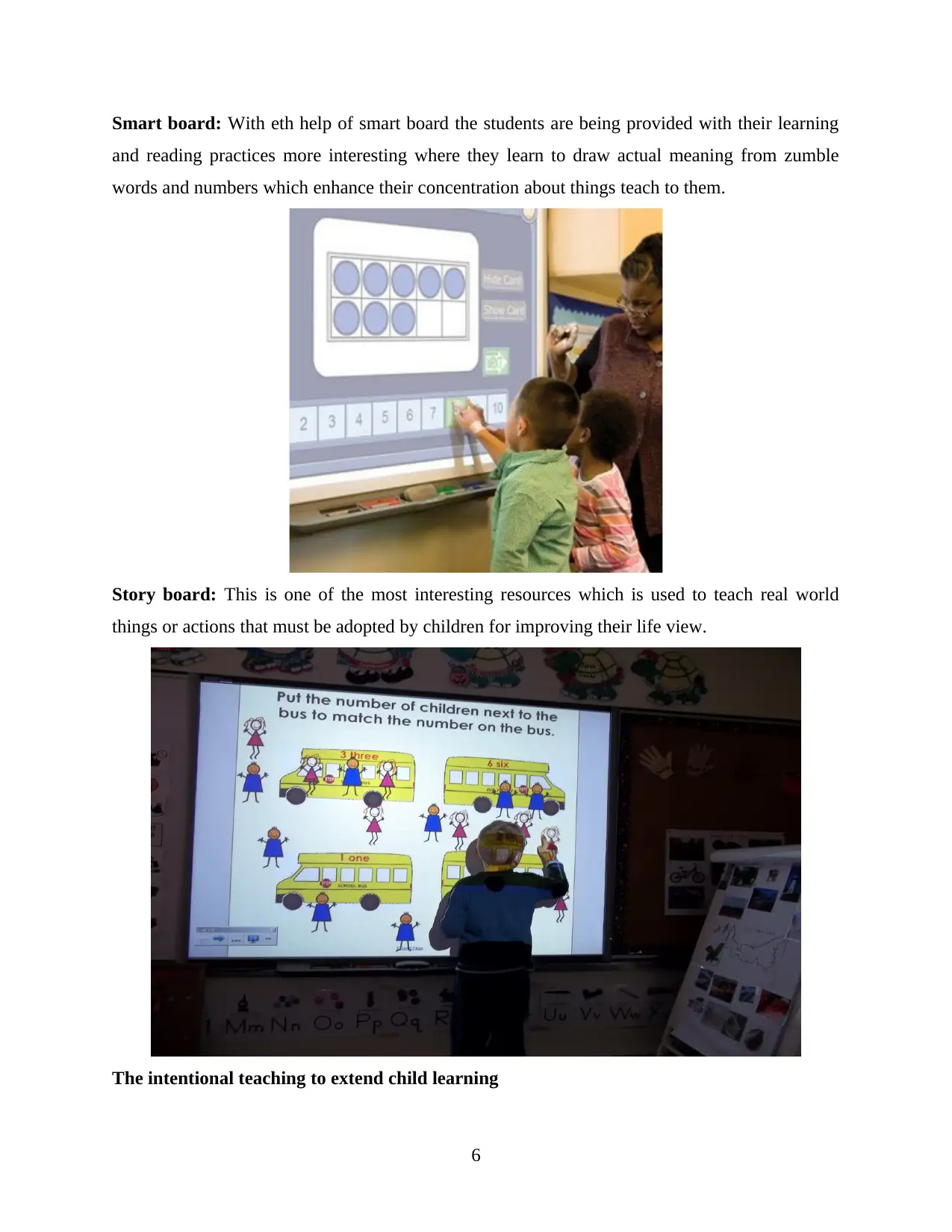
Smart board: With eth help of smart board the students are being provided with their learning
and reading practices more interesting where they learn to draw actual meaning from zumble
words and numbers which enhance their concentration about things teach to them.
Story board: This is one of the most interesting resources which is used to teach real world
things or actions that must be adopted by children for improving their life view.
The intentional teaching to extend child learning
6
and reading practices more interesting where they learn to draw actual meaning from zumble
words and numbers which enhance their concentration about things teach to them.
Story board: This is one of the most interesting resources which is used to teach real world
things or actions that must be adopted by children for improving their life view.
The intentional teaching to extend child learning
6
⊘ This is a preview!⊘
Do you want full access?
Subscribe today to unlock all pages.

Trusted by 1+ million students worldwide
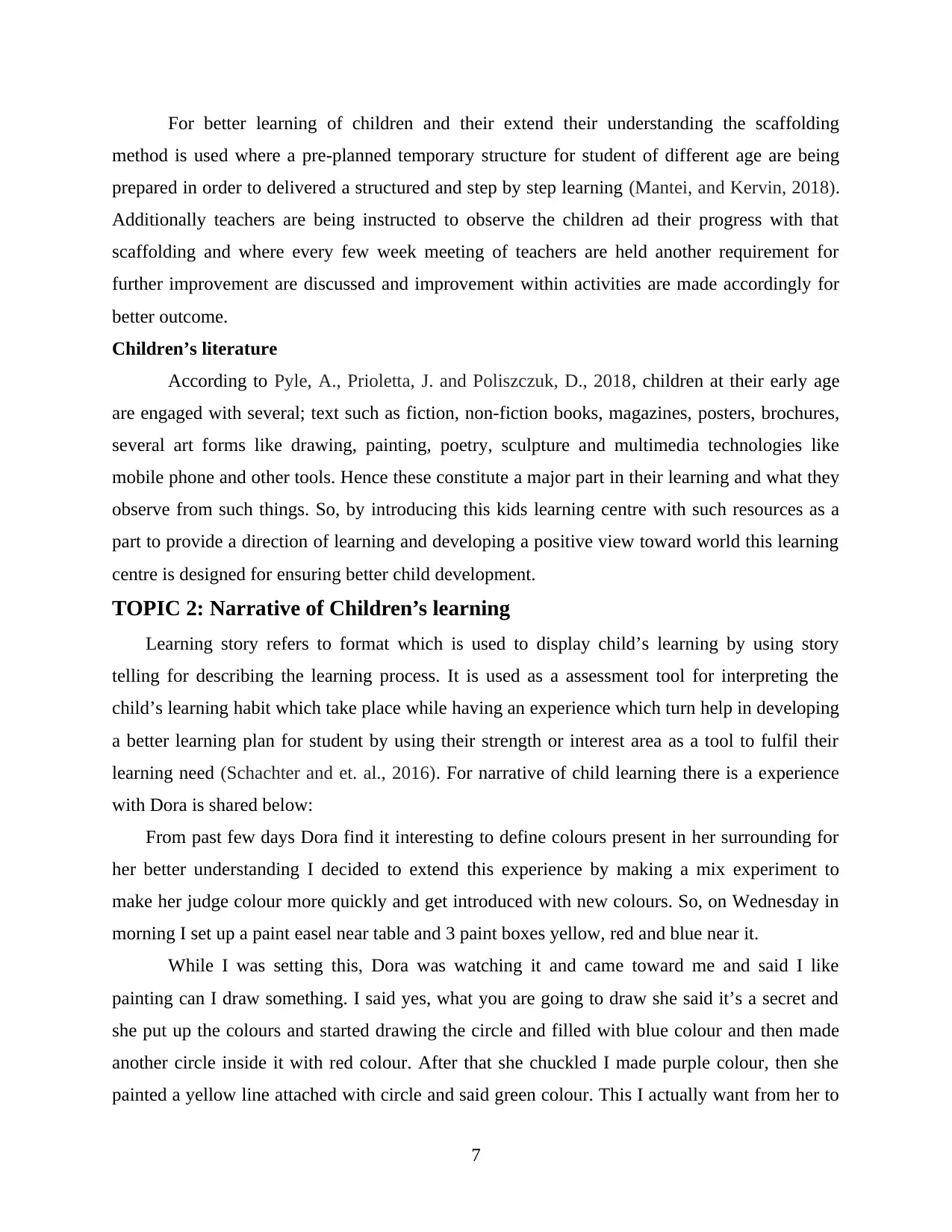
For better learning of children and their extend their understanding the scaffolding
method is used where a pre-planned temporary structure for student of different age are being
prepared in order to delivered a structured and step by step learning (Mantei, and Kervin, 2018).
Additionally teachers are being instructed to observe the children ad their progress with that
scaffolding and where every few week meeting of teachers are held another requirement for
further improvement are discussed and improvement within activities are made accordingly for
better outcome.
Children’s literature
According to Pyle, A., Prioletta, J. and Poliszczuk, D., 2018, children at their early age
are engaged with several; text such as fiction, non-fiction books, magazines, posters, brochures,
several art forms like drawing, painting, poetry, sculpture and multimedia technologies like
mobile phone and other tools. Hence these constitute a major part in their learning and what they
observe from such things. So, by introducing this kids learning centre with such resources as a
part to provide a direction of learning and developing a positive view toward world this learning
centre is designed for ensuring better child development.
TOPIC 2: Narrative of Children’s learning
Learning story refers to format which is used to display child’s learning by using story
telling for describing the learning process. It is used as a assessment tool for interpreting the
child’s learning habit which take place while having an experience which turn help in developing
a better learning plan for student by using their strength or interest area as a tool to fulfil their
learning need (Schachter and et. al., 2016). For narrative of child learning there is a experience
with Dora is shared below:
From past few days Dora find it interesting to define colours present in her surrounding for
her better understanding I decided to extend this experience by making a mix experiment to
make her judge colour more quickly and get introduced with new colours. So, on Wednesday in
morning I set up a paint easel near table and 3 paint boxes yellow, red and blue near it.
While I was setting this, Dora was watching it and came toward me and said I like
painting can I draw something. I said yes, what you are going to draw she said it’s a secret and
she put up the colours and started drawing the circle and filled with blue colour and then made
another circle inside it with red colour. After that she chuckled I made purple colour, then she
painted a yellow line attached with circle and said green colour. This I actually want from her to
7
method is used where a pre-planned temporary structure for student of different age are being
prepared in order to delivered a structured and step by step learning (Mantei, and Kervin, 2018).
Additionally teachers are being instructed to observe the children ad their progress with that
scaffolding and where every few week meeting of teachers are held another requirement for
further improvement are discussed and improvement within activities are made accordingly for
better outcome.
Children’s literature
According to Pyle, A., Prioletta, J. and Poliszczuk, D., 2018, children at their early age
are engaged with several; text such as fiction, non-fiction books, magazines, posters, brochures,
several art forms like drawing, painting, poetry, sculpture and multimedia technologies like
mobile phone and other tools. Hence these constitute a major part in their learning and what they
observe from such things. So, by introducing this kids learning centre with such resources as a
part to provide a direction of learning and developing a positive view toward world this learning
centre is designed for ensuring better child development.
TOPIC 2: Narrative of Children’s learning
Learning story refers to format which is used to display child’s learning by using story
telling for describing the learning process. It is used as a assessment tool for interpreting the
child’s learning habit which take place while having an experience which turn help in developing
a better learning plan for student by using their strength or interest area as a tool to fulfil their
learning need (Schachter and et. al., 2016). For narrative of child learning there is a experience
with Dora is shared below:
From past few days Dora find it interesting to define colours present in her surrounding for
her better understanding I decided to extend this experience by making a mix experiment to
make her judge colour more quickly and get introduced with new colours. So, on Wednesday in
morning I set up a paint easel near table and 3 paint boxes yellow, red and blue near it.
While I was setting this, Dora was watching it and came toward me and said I like
painting can I draw something. I said yes, what you are going to draw she said it’s a secret and
she put up the colours and started drawing the circle and filled with blue colour and then made
another circle inside it with red colour. After that she chuckled I made purple colour, then she
painted a yellow line attached with circle and said green colour. This I actually want from her to
7
Paraphrase This Document
Need a fresh take? Get an instant paraphrase of this document with our AI Paraphraser
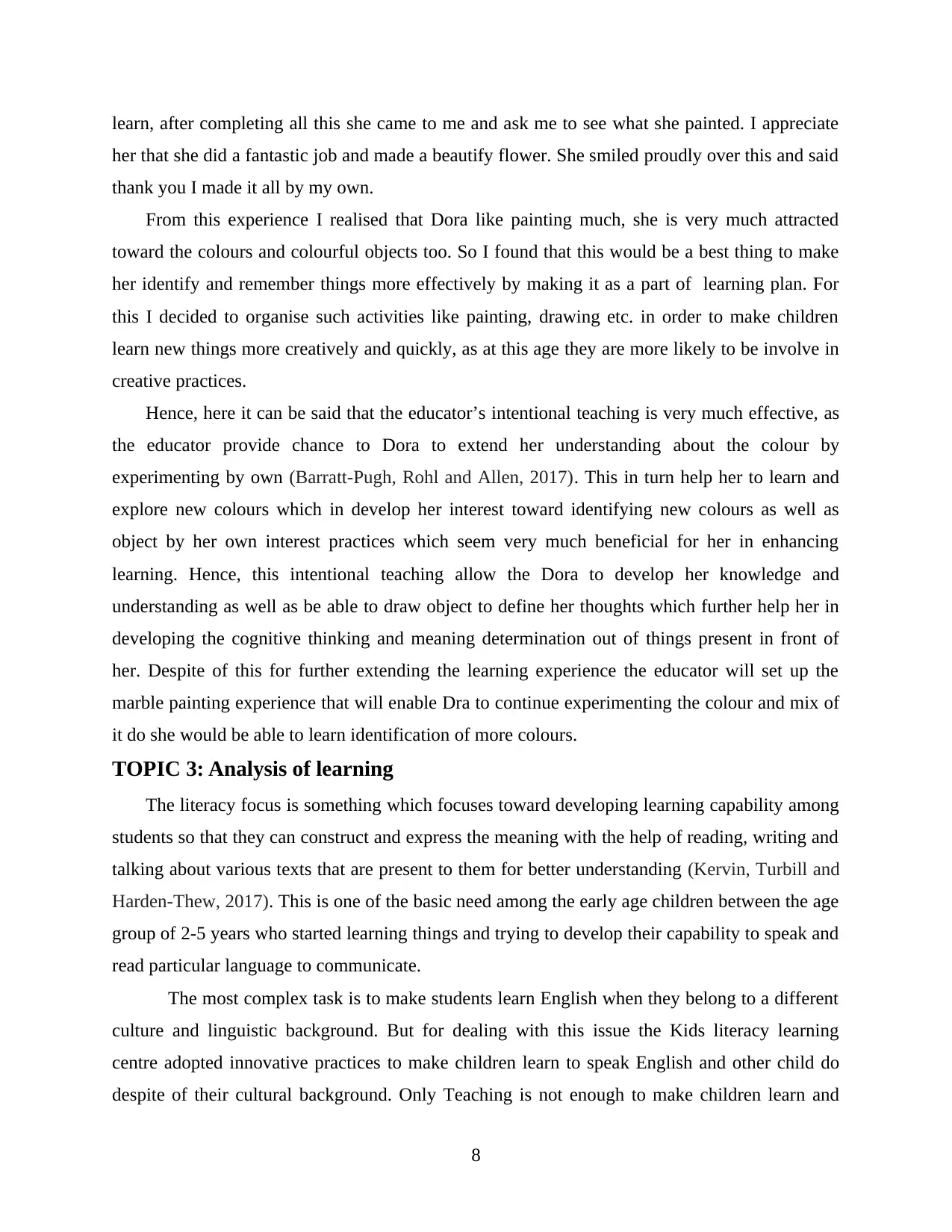
learn, after completing all this she came to me and ask me to see what she painted. I appreciate
her that she did a fantastic job and made a beautify flower. She smiled proudly over this and said
thank you I made it all by my own.
From this experience I realised that Dora like painting much, she is very much attracted
toward the colours and colourful objects too. So I found that this would be a best thing to make
her identify and remember things more effectively by making it as a part of learning plan. For
this I decided to organise such activities like painting, drawing etc. in order to make children
learn new things more creatively and quickly, as at this age they are more likely to be involve in
creative practices.
Hence, here it can be said that the educator’s intentional teaching is very much effective, as
the educator provide chance to Dora to extend her understanding about the colour by
experimenting by own (Barratt-Pugh, Rohl and Allen, 2017). This in turn help her to learn and
explore new colours which in develop her interest toward identifying new colours as well as
object by her own interest practices which seem very much beneficial for her in enhancing
learning. Hence, this intentional teaching allow the Dora to develop her knowledge and
understanding as well as be able to draw object to define her thoughts which further help her in
developing the cognitive thinking and meaning determination out of things present in front of
her. Despite of this for further extending the learning experience the educator will set up the
marble painting experience that will enable Dra to continue experimenting the colour and mix of
it do she would be able to learn identification of more colours.
TOPIC 3: Analysis of learning
The literacy focus is something which focuses toward developing learning capability among
students so that they can construct and express the meaning with the help of reading, writing and
talking about various texts that are present to them for better understanding (Kervin, Turbill and
Harden-Thew, 2017). This is one of the basic need among the early age children between the age
group of 2-5 years who started learning things and trying to develop their capability to speak and
read particular language to communicate.
The most complex task is to make students learn English when they belong to a different
culture and linguistic background. But for dealing with this issue the Kids literacy learning
centre adopted innovative practices to make children learn to speak English and other child do
despite of their cultural background. Only Teaching is not enough to make children learn and
8
her that she did a fantastic job and made a beautify flower. She smiled proudly over this and said
thank you I made it all by my own.
From this experience I realised that Dora like painting much, she is very much attracted
toward the colours and colourful objects too. So I found that this would be a best thing to make
her identify and remember things more effectively by making it as a part of learning plan. For
this I decided to organise such activities like painting, drawing etc. in order to make children
learn new things more creatively and quickly, as at this age they are more likely to be involve in
creative practices.
Hence, here it can be said that the educator’s intentional teaching is very much effective, as
the educator provide chance to Dora to extend her understanding about the colour by
experimenting by own (Barratt-Pugh, Rohl and Allen, 2017). This in turn help her to learn and
explore new colours which in develop her interest toward identifying new colours as well as
object by her own interest practices which seem very much beneficial for her in enhancing
learning. Hence, this intentional teaching allow the Dora to develop her knowledge and
understanding as well as be able to draw object to define her thoughts which further help her in
developing the cognitive thinking and meaning determination out of things present in front of
her. Despite of this for further extending the learning experience the educator will set up the
marble painting experience that will enable Dra to continue experimenting the colour and mix of
it do she would be able to learn identification of more colours.
TOPIC 3: Analysis of learning
The literacy focus is something which focuses toward developing learning capability among
students so that they can construct and express the meaning with the help of reading, writing and
talking about various texts that are present to them for better understanding (Kervin, Turbill and
Harden-Thew, 2017). This is one of the basic need among the early age children between the age
group of 2-5 years who started learning things and trying to develop their capability to speak and
read particular language to communicate.
The most complex task is to make students learn English when they belong to a different
culture and linguistic background. But for dealing with this issue the Kids literacy learning
centre adopted innovative practices to make children learn to speak English and other child do
despite of their cultural background. Only Teaching is not enough to make children learn and
8
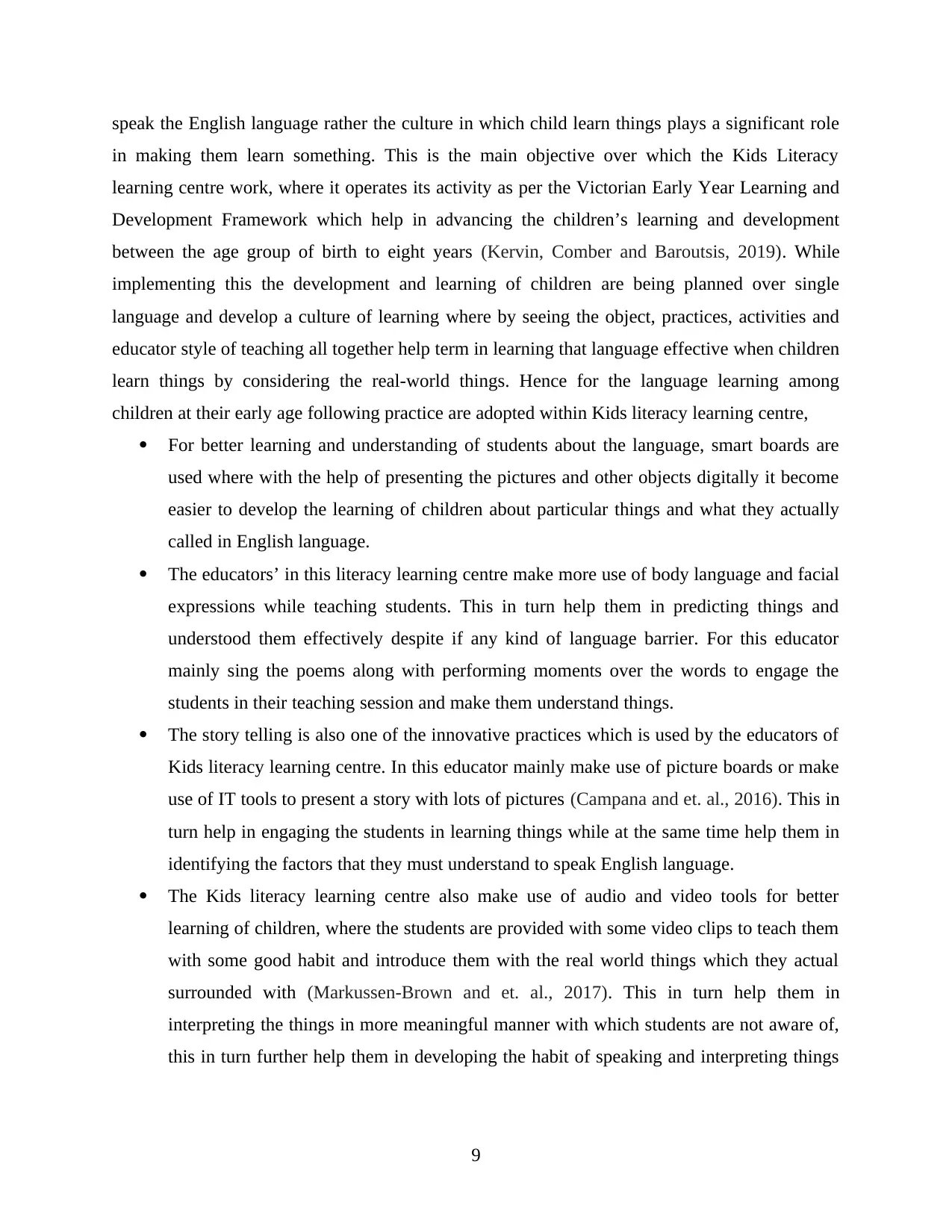
speak the English language rather the culture in which child learn things plays a significant role
in making them learn something. This is the main objective over which the Kids Literacy
learning centre work, where it operates its activity as per the Victorian Early Year Learning and
Development Framework which help in advancing the children’s learning and development
between the age group of birth to eight years (Kervin, Comber and Baroutsis, 2019). While
implementing this the development and learning of children are being planned over single
language and develop a culture of learning where by seeing the object, practices, activities and
educator style of teaching all together help term in learning that language effective when children
learn things by considering the real-world things. Hence for the language learning among
children at their early age following practice are adopted within Kids literacy learning centre,
For better learning and understanding of students about the language, smart boards are
used where with the help of presenting the pictures and other objects digitally it become
easier to develop the learning of children about particular things and what they actually
called in English language.
The educators’ in this literacy learning centre make more use of body language and facial
expressions while teaching students. This in turn help them in predicting things and
understood them effectively despite if any kind of language barrier. For this educator
mainly sing the poems along with performing moments over the words to engage the
students in their teaching session and make them understand things.
The story telling is also one of the innovative practices which is used by the educators of
Kids literacy learning centre. In this educator mainly make use of picture boards or make
use of IT tools to present a story with lots of pictures (Campana and et. al., 2016). This in
turn help in engaging the students in learning things while at the same time help them in
identifying the factors that they must understand to speak English language.
The Kids literacy learning centre also make use of audio and video tools for better
learning of children, where the students are provided with some video clips to teach them
with some good habit and introduce them with the real world things which they actual
surrounded with (Markussen-Brown and et. al., 2017). This in turn help them in
interpreting the things in more meaningful manner with which students are not aware of,
this in turn further help them in developing the habit of speaking and interpreting things
9
in making them learn something. This is the main objective over which the Kids Literacy
learning centre work, where it operates its activity as per the Victorian Early Year Learning and
Development Framework which help in advancing the children’s learning and development
between the age group of birth to eight years (Kervin, Comber and Baroutsis, 2019). While
implementing this the development and learning of children are being planned over single
language and develop a culture of learning where by seeing the object, practices, activities and
educator style of teaching all together help term in learning that language effective when children
learn things by considering the real-world things. Hence for the language learning among
children at their early age following practice are adopted within Kids literacy learning centre,
For better learning and understanding of students about the language, smart boards are
used where with the help of presenting the pictures and other objects digitally it become
easier to develop the learning of children about particular things and what they actually
called in English language.
The educators’ in this literacy learning centre make more use of body language and facial
expressions while teaching students. This in turn help them in predicting things and
understood them effectively despite if any kind of language barrier. For this educator
mainly sing the poems along with performing moments over the words to engage the
students in their teaching session and make them understand things.
The story telling is also one of the innovative practices which is used by the educators of
Kids literacy learning centre. In this educator mainly make use of picture boards or make
use of IT tools to present a story with lots of pictures (Campana and et. al., 2016). This in
turn help in engaging the students in learning things while at the same time help them in
identifying the factors that they must understand to speak English language.
The Kids literacy learning centre also make use of audio and video tools for better
learning of children, where the students are provided with some video clips to teach them
with some good habit and introduce them with the real world things which they actual
surrounded with (Markussen-Brown and et. al., 2017). This in turn help them in
interpreting the things in more meaningful manner with which students are not aware of,
this in turn further help them in developing the habit of speaking and interpreting things
9
⊘ This is a preview!⊘
Do you want full access?
Subscribe today to unlock all pages.

Trusted by 1+ million students worldwide
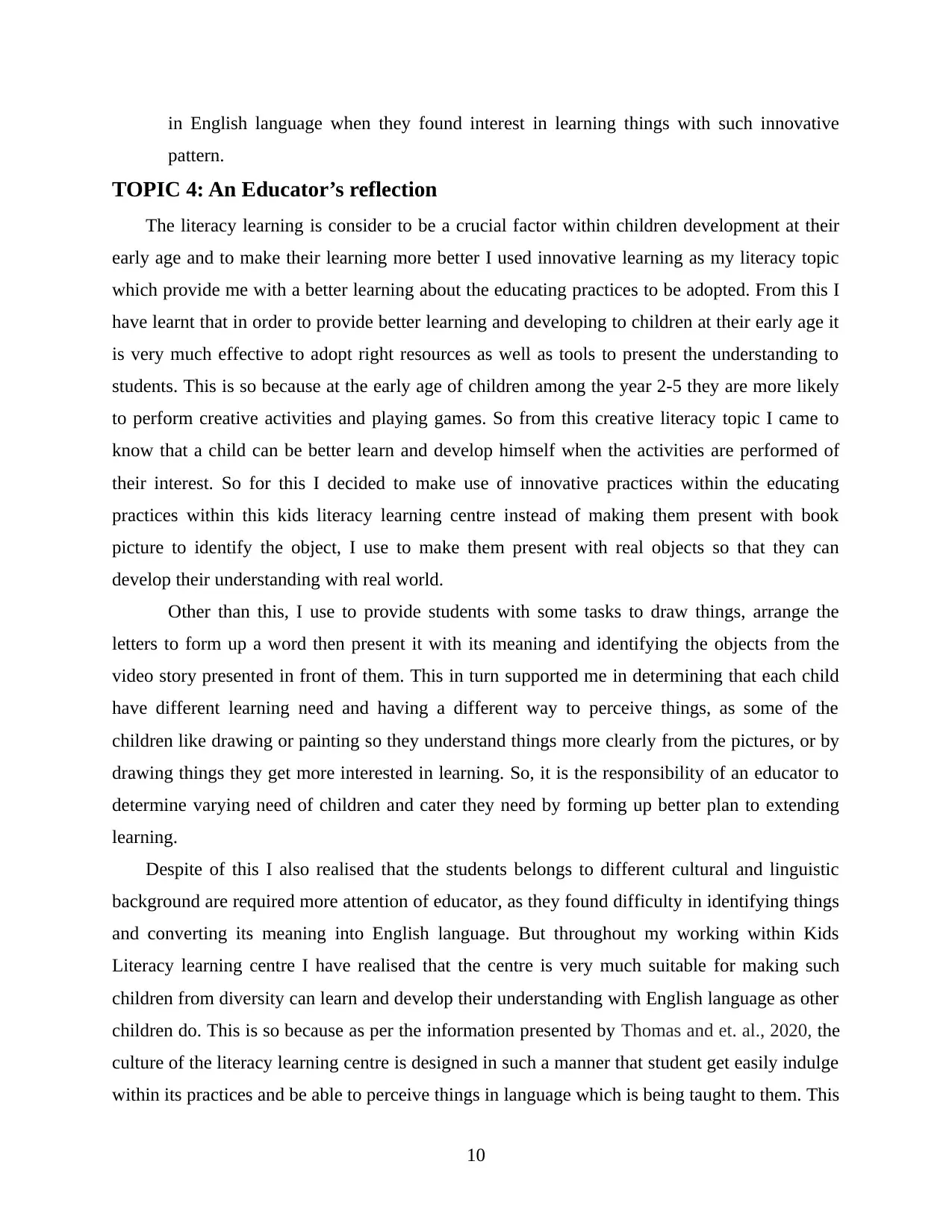
in English language when they found interest in learning things with such innovative
pattern.
TOPIC 4: An Educator’s reflection
The literacy learning is consider to be a crucial factor within children development at their
early age and to make their learning more better I used innovative learning as my literacy topic
which provide me with a better learning about the educating practices to be adopted. From this I
have learnt that in order to provide better learning and developing to children at their early age it
is very much effective to adopt right resources as well as tools to present the understanding to
students. This is so because at the early age of children among the year 2-5 they are more likely
to perform creative activities and playing games. So from this creative literacy topic I came to
know that a child can be better learn and develop himself when the activities are performed of
their interest. So for this I decided to make use of innovative practices within the educating
practices within this kids literacy learning centre instead of making them present with book
picture to identify the object, I use to make them present with real objects so that they can
develop their understanding with real world.
Other than this, I use to provide students with some tasks to draw things, arrange the
letters to form up a word then present it with its meaning and identifying the objects from the
video story presented in front of them. This in turn supported me in determining that each child
have different learning need and having a different way to perceive things, as some of the
children like drawing or painting so they understand things more clearly from the pictures, or by
drawing things they get more interested in learning. So, it is the responsibility of an educator to
determine varying need of children and cater they need by forming up better plan to extending
learning.
Despite of this I also realised that the students belongs to different cultural and linguistic
background are required more attention of educator, as they found difficulty in identifying things
and converting its meaning into English language. But throughout my working within Kids
Literacy learning centre I have realised that the centre is very much suitable for making such
children from diversity can learn and develop their understanding with English language as other
children do. This is so because as per the information presented by Thomas and et. al., 2020, the
culture of the literacy learning centre is designed in such a manner that student get easily indulge
within its practices and be able to perceive things in language which is being taught to them. This
10
pattern.
TOPIC 4: An Educator’s reflection
The literacy learning is consider to be a crucial factor within children development at their
early age and to make their learning more better I used innovative learning as my literacy topic
which provide me with a better learning about the educating practices to be adopted. From this I
have learnt that in order to provide better learning and developing to children at their early age it
is very much effective to adopt right resources as well as tools to present the understanding to
students. This is so because at the early age of children among the year 2-5 they are more likely
to perform creative activities and playing games. So from this creative literacy topic I came to
know that a child can be better learn and develop himself when the activities are performed of
their interest. So for this I decided to make use of innovative practices within the educating
practices within this kids literacy learning centre instead of making them present with book
picture to identify the object, I use to make them present with real objects so that they can
develop their understanding with real world.
Other than this, I use to provide students with some tasks to draw things, arrange the
letters to form up a word then present it with its meaning and identifying the objects from the
video story presented in front of them. This in turn supported me in determining that each child
have different learning need and having a different way to perceive things, as some of the
children like drawing or painting so they understand things more clearly from the pictures, or by
drawing things they get more interested in learning. So, it is the responsibility of an educator to
determine varying need of children and cater they need by forming up better plan to extending
learning.
Despite of this I also realised that the students belongs to different cultural and linguistic
background are required more attention of educator, as they found difficulty in identifying things
and converting its meaning into English language. But throughout my working within Kids
Literacy learning centre I have realised that the centre is very much suitable for making such
children from diversity can learn and develop their understanding with English language as other
children do. This is so because as per the information presented by Thomas and et. al., 2020, the
culture of the literacy learning centre is designed in such a manner that student get easily indulge
within its practices and be able to perceive things in language which is being taught to them. This
10
Paraphrase This Document
Need a fresh take? Get an instant paraphrase of this document with our AI Paraphraser
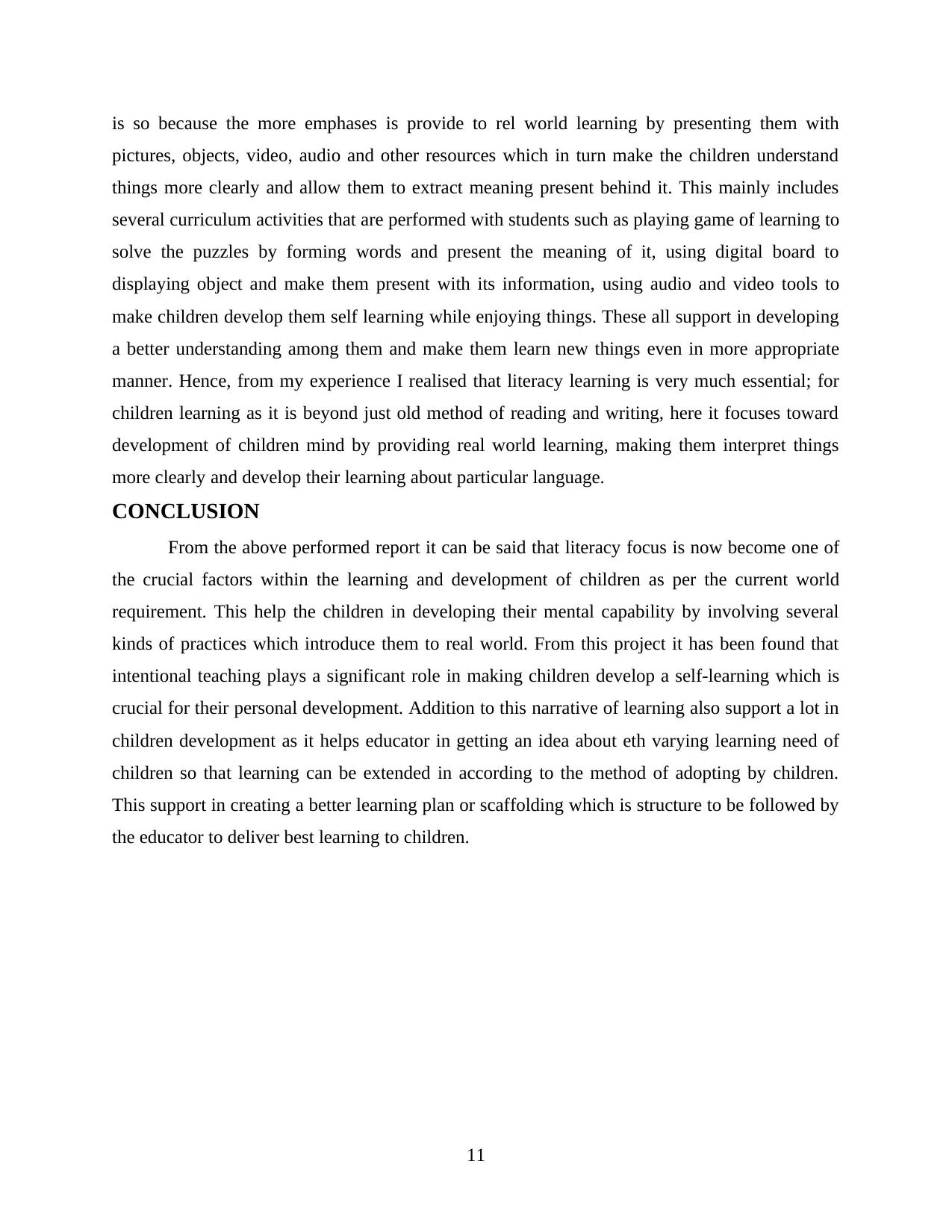
is so because the more emphases is provide to rel world learning by presenting them with
pictures, objects, video, audio and other resources which in turn make the children understand
things more clearly and allow them to extract meaning present behind it. This mainly includes
several curriculum activities that are performed with students such as playing game of learning to
solve the puzzles by forming words and present the meaning of it, using digital board to
displaying object and make them present with its information, using audio and video tools to
make children develop them self learning while enjoying things. These all support in developing
a better understanding among them and make them learn new things even in more appropriate
manner. Hence, from my experience I realised that literacy learning is very much essential; for
children learning as it is beyond just old method of reading and writing, here it focuses toward
development of children mind by providing real world learning, making them interpret things
more clearly and develop their learning about particular language.
CONCLUSION
From the above performed report it can be said that literacy focus is now become one of
the crucial factors within the learning and development of children as per the current world
requirement. This help the children in developing their mental capability by involving several
kinds of practices which introduce them to real world. From this project it has been found that
intentional teaching plays a significant role in making children develop a self-learning which is
crucial for their personal development. Addition to this narrative of learning also support a lot in
children development as it helps educator in getting an idea about eth varying learning need of
children so that learning can be extended in according to the method of adopting by children.
This support in creating a better learning plan or scaffolding which is structure to be followed by
the educator to deliver best learning to children.
11
pictures, objects, video, audio and other resources which in turn make the children understand
things more clearly and allow them to extract meaning present behind it. This mainly includes
several curriculum activities that are performed with students such as playing game of learning to
solve the puzzles by forming words and present the meaning of it, using digital board to
displaying object and make them present with its information, using audio and video tools to
make children develop them self learning while enjoying things. These all support in developing
a better understanding among them and make them learn new things even in more appropriate
manner. Hence, from my experience I realised that literacy learning is very much essential; for
children learning as it is beyond just old method of reading and writing, here it focuses toward
development of children mind by providing real world learning, making them interpret things
more clearly and develop their learning about particular language.
CONCLUSION
From the above performed report it can be said that literacy focus is now become one of
the crucial factors within the learning and development of children as per the current world
requirement. This help the children in developing their mental capability by involving several
kinds of practices which introduce them to real world. From this project it has been found that
intentional teaching plays a significant role in making children develop a self-learning which is
crucial for their personal development. Addition to this narrative of learning also support a lot in
children development as it helps educator in getting an idea about eth varying learning need of
children so that learning can be extended in according to the method of adopting by children.
This support in creating a better learning plan or scaffolding which is structure to be followed by
the educator to deliver best learning to children.
11
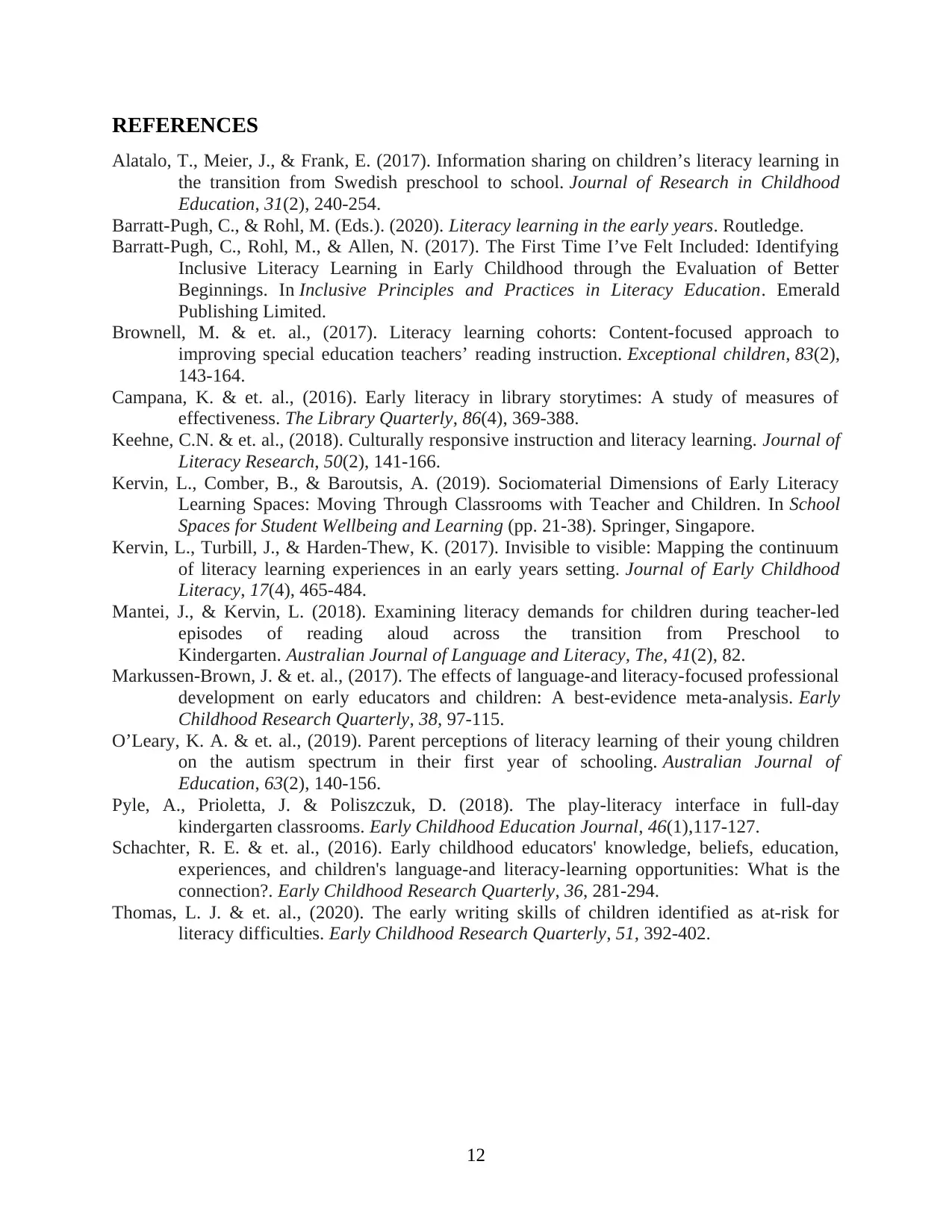
REFERENCES
Alatalo, T., Meier, J., & Frank, E. (2017). Information sharing on children’s literacy learning in
the transition from Swedish preschool to school. Journal of Research in Childhood
Education, 31(2), 240-254.
Barratt-Pugh, C., & Rohl, M. (Eds.). (2020). Literacy learning in the early years. Routledge.
Barratt-Pugh, C., Rohl, M., & Allen, N. (2017). The First Time I’ve Felt Included: Identifying
Inclusive Literacy Learning in Early Childhood through the Evaluation of Better
Beginnings. In Inclusive Principles and Practices in Literacy Education. Emerald
Publishing Limited.
Brownell, M. & et. al., (2017). Literacy learning cohorts: Content-focused approach to
improving special education teachers’ reading instruction. Exceptional children, 83(2),
143-164.
Campana, K. & et. al., (2016). Early literacy in library storytimes: A study of measures of
effectiveness. The Library Quarterly, 86(4), 369-388.
Keehne, C.N. & et. al., (2018). Culturally responsive instruction and literacy learning. Journal of
Literacy Research, 50(2), 141-166.
Kervin, L., Comber, B., & Baroutsis, A. (2019). Sociomaterial Dimensions of Early Literacy
Learning Spaces: Moving Through Classrooms with Teacher and Children. In School
Spaces for Student Wellbeing and Learning (pp. 21-38). Springer, Singapore.
Kervin, L., Turbill, J., & Harden-Thew, K. (2017). Invisible to visible: Mapping the continuum
of literacy learning experiences in an early years setting. Journal of Early Childhood
Literacy, 17(4), 465-484.
Mantei, J., & Kervin, L. (2018). Examining literacy demands for children during teacher-led
episodes of reading aloud across the transition from Preschool to
Kindergarten. Australian Journal of Language and Literacy, The, 41(2), 82.
Markussen-Brown, J. & et. al., (2017). The effects of language-and literacy-focused professional
development on early educators and children: A best-evidence meta-analysis. Early
Childhood Research Quarterly, 38, 97-115.
O’Leary, K. A. & et. al., (2019). Parent perceptions of literacy learning of their young children
on the autism spectrum in their first year of schooling. Australian Journal of
Education, 63(2), 140-156.
Pyle, A., Prioletta, J. & Poliszczuk, D. (2018). The play-literacy interface in full-day
kindergarten classrooms. Early Childhood Education Journal, 46(1),117-127.
Schachter, R. E. & et. al., (2016). Early childhood educators' knowledge, beliefs, education,
experiences, and children's language-and literacy-learning opportunities: What is the
connection?. Early Childhood Research Quarterly, 36, 281-294.
Thomas, L. J. & et. al., (2020). The early writing skills of children identified as at-risk for
literacy difficulties. Early Childhood Research Quarterly, 51, 392-402.
12
Alatalo, T., Meier, J., & Frank, E. (2017). Information sharing on children’s literacy learning in
the transition from Swedish preschool to school. Journal of Research in Childhood
Education, 31(2), 240-254.
Barratt-Pugh, C., & Rohl, M. (Eds.). (2020). Literacy learning in the early years. Routledge.
Barratt-Pugh, C., Rohl, M., & Allen, N. (2017). The First Time I’ve Felt Included: Identifying
Inclusive Literacy Learning in Early Childhood through the Evaluation of Better
Beginnings. In Inclusive Principles and Practices in Literacy Education. Emerald
Publishing Limited.
Brownell, M. & et. al., (2017). Literacy learning cohorts: Content-focused approach to
improving special education teachers’ reading instruction. Exceptional children, 83(2),
143-164.
Campana, K. & et. al., (2016). Early literacy in library storytimes: A study of measures of
effectiveness. The Library Quarterly, 86(4), 369-388.
Keehne, C.N. & et. al., (2018). Culturally responsive instruction and literacy learning. Journal of
Literacy Research, 50(2), 141-166.
Kervin, L., Comber, B., & Baroutsis, A. (2019). Sociomaterial Dimensions of Early Literacy
Learning Spaces: Moving Through Classrooms with Teacher and Children. In School
Spaces for Student Wellbeing and Learning (pp. 21-38). Springer, Singapore.
Kervin, L., Turbill, J., & Harden-Thew, K. (2017). Invisible to visible: Mapping the continuum
of literacy learning experiences in an early years setting. Journal of Early Childhood
Literacy, 17(4), 465-484.
Mantei, J., & Kervin, L. (2018). Examining literacy demands for children during teacher-led
episodes of reading aloud across the transition from Preschool to
Kindergarten. Australian Journal of Language and Literacy, The, 41(2), 82.
Markussen-Brown, J. & et. al., (2017). The effects of language-and literacy-focused professional
development on early educators and children: A best-evidence meta-analysis. Early
Childhood Research Quarterly, 38, 97-115.
O’Leary, K. A. & et. al., (2019). Parent perceptions of literacy learning of their young children
on the autism spectrum in their first year of schooling. Australian Journal of
Education, 63(2), 140-156.
Pyle, A., Prioletta, J. & Poliszczuk, D. (2018). The play-literacy interface in full-day
kindergarten classrooms. Early Childhood Education Journal, 46(1),117-127.
Schachter, R. E. & et. al., (2016). Early childhood educators' knowledge, beliefs, education,
experiences, and children's language-and literacy-learning opportunities: What is the
connection?. Early Childhood Research Quarterly, 36, 281-294.
Thomas, L. J. & et. al., (2020). The early writing skills of children identified as at-risk for
literacy difficulties. Early Childhood Research Quarterly, 51, 392-402.
12
⊘ This is a preview!⊘
Do you want full access?
Subscribe today to unlock all pages.

Trusted by 1+ million students worldwide
1 out of 12
Related Documents
Your All-in-One AI-Powered Toolkit for Academic Success.
+13062052269
info@desklib.com
Available 24*7 on WhatsApp / Email
![[object Object]](/_next/static/media/star-bottom.7253800d.svg)
Unlock your academic potential
Copyright © 2020–2025 A2Z Services. All Rights Reserved. Developed and managed by ZUCOL.




